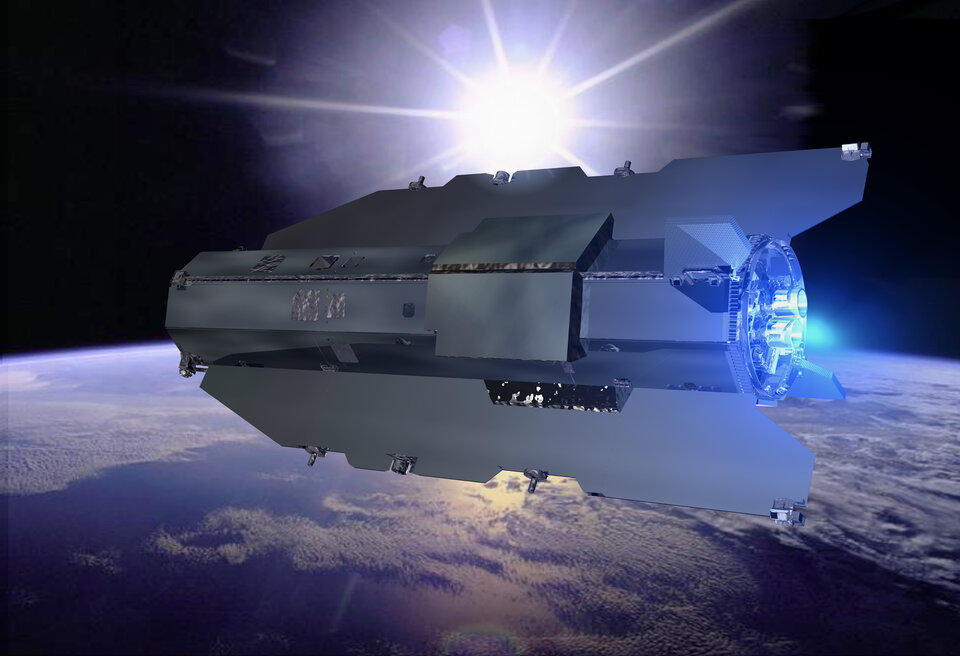Scientists view GOCE satellite
With launch scheduled for December this year, scientists and engineers recently gathered at Alcatel Alenia Space in Turin, Italy, to take a look at the GOCE satellite where the last subsystems are being integrated on the spacecraft platform.
The GOCE (Gravity field and steady-state Ocean Circulation Explorer) mission is dedicated to measuring the Earth's gravity field and modelling the geoid with unprecedented accuracy and spatial resolution. This will be achieved by employing an Electrostatic Gravity Gradiometer (EGG), which consists of three pairs of identical ultra-sensitive accelerometers mounted on three mutually orthogonal 'gradiometer arms'.
The last pair of accelerometer sensor head flight models have been completed by ONERA and delivered to Alcatel Alenia Space (AAS-F) in Cannes. While the first two pairs have already been integrated and aligned, the last pair completes the gradiometer core and marks an important milestone. In parallel to the completion of the EGG flight model core in Cannes, the Gradiometer Flight Model (FM) electronics and Core Structural Thermal Model (STM) have been mechanically and electrically integrated on the Platform Proto Flight Model (PFM) at Alcatel Alenia Space in Turin.

In addition, a GPS-based Satellite-to-Satellite Tracking System (SSTI) developed by Alcatel Alenia Space in Milan, has also been integrated into the satellite to provide accurate positioning of the satellite when in orbit. The last touch will be the completion of the Ion Propulsion Assembly integration and testing. The last touch will be the completion of the Ion Propulsion Assembly integration and testing. Additional testing will then be carried out prior to shipment of the satellite to ESA-ESTEC in the Netherlands in May - where the Gradiometer Core STM will be replaced by the Gradiometer Core PFM.
Unlike other spacecraft that act as a passive platform carrying various independent instruments, GOCE is unique because once the gradiometer and SSTI instruments are incorporated into the satellite, they becomes an intrinsic part of an integrated measurement and control system. With no moving devices, so that any 'false gravity readings' are avoided, the satellite and the system of sensors form one extraordinarily sensitive gravity-measuring device.

Andrea Allasio, Alcatel Alenia Space GOCE Project Manager, said that, "The project has indeed been very challenging and many technology developments and specific solutions have been undertaken by the industrial consortium for this demanding gravity mission. All this, together with the features implemented for accurately predicting the in-flight performance, which are not measurable on ground, brings about a significant achievement that will also benefit future space projects. With the technology in place, our engineers and technicians are covering a six-day week to complete the integration and testing programme, ultimately giving the scientists the means to realise the data that the GOCE mission promises to deliver."
Wearing protective clothing, ESA project scientists and engineers were lucky enough to be able to take a close look the gradiometer installation and the slim, five-metre long GOCE spacecraft being cradled in its purpose-built frame in the clean room at Alcatel Alenia Space, the Prime Contractor for the GOCE mission.

Reiner Rummel, Chair GOCE Mission Advisory Group stated that, "It is a really exciting moment for us scientists to finally see the real GOCE satellite in front of us. So many excellent ideas, good thinking, numerical tests and superb engineering went into it. It turned out to be an extremely demanding and very unique satellite system and we have deep appreciation for the excellent work performed by the engineers. Now we cross our fingers and hope for a successful launch in order to do the science we have prepared for."

In just nine months time GOCE will be launched on a modified Intercontinental Ballistic Missile SS-19 launcher called Rockot from the Plesetsk Cosmodrome in northern Russia. The launch will also mark a historic achievement as it will be the first in the family of the Earth Explorer satellites within ESA's Living Planet Programme to reach orbit.
From a particularly low orbital altitude of just 250 km, GOCE will, over its 20-month lifetime, map the Earth's gravity field and associated geoid. These data will advance our knowledge of ocean circulation, which plays a crucial role in energy exchanges around the globe, sea-level change and processes occurring within the Earth's interior. The mission will also make significant advances in the field of geodesy and surveying.
Before final shipment to the launch site later this year, the GOCE satellite and the gradiometer will undergo its final integration and environmental testing programme including acoustic and other tests at ESA's facilities in Noordwijk, the Netherlands. This last phase in testing will make absolutely sure that everything is in order to withstand the rigors of launch and hostile conditions it will experience in space.















 Germany
Germany
 Austria
Austria
 Belgium
Belgium
 Denmark
Denmark
 Spain
Spain
 Estonia
Estonia
 Finland
Finland
 France
France
 Greece
Greece
 Hungary
Hungary
 Ireland
Ireland
 Italy
Italy
 Luxembourg
Luxembourg
 Norway
Norway
 The Netherlands
The Netherlands
 Poland
Poland
 Portugal
Portugal
 Czechia
Czechia
 Romania
Romania
 United Kingdom
United Kingdom
 Slovenia
Slovenia
 Sweden
Sweden
 Switzerland
Switzerland
































